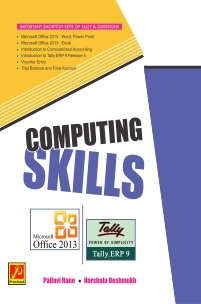Basic of Android Development
Prof Digambar P Mahajan- ISBN: 9789395227971
- Published : April 2023
- Book Language : English
- Edition : Student
- Format : Paperback
- Pages : 228
- Categories: Computer / Tally / E-commerce, Computer Science
Rs.395.00
“Building your first Android app : From novice to developer!” is a slogan that encapsulates the core message and value proposition of the book on basic Android development.
The slogan highlights that the book is designed for beginners who have little or no prior experience in Android development, and aims to provide them with a comprehensive introduction to the basics of Android development. The book starts with the fundamentals of Android architecture and Java programming, and gradually progresses towards the development of complete Android applications. The slogan emphasizes that the book is focused on practical, hands-on learning, with a variety of exercises and examples provided throughout the book to help readers develop their skills and understanding. The book aims to empower readers to become proficient Android developers and provide them with the knowledge and skills they need to create their own Android applications.
1. Introduction to Mobile Computing and Android
1.1 Mobile Computing : Introduction to Mobile Computing
A. Applications, B. Limitations, C. Pocket Pc, D. Native Android Applications and Example, E. Introduction to handheld devices Palm, i. This application of palm devices, ii. Advantage and disadvantage of palm devices, iii. Features of handheld devices, iv. Overview of application development platforms OS-Palm OS, F. Introduction Symbian OS smart phones, i. Application Symbian OS smart phones, ii. Advantage and disadvantage Symbian OS smart phones, G. Introduction to MS windows based smart phones, i. Advantage And Disadvantage MS windows based smart phones, ii. Application of MS windows based smart phones, H. Introduction Device Applications Vs Desktop application, I. Introduction Device Applications Type and Example, J. Desktop Application Type And Example, K. Comparison of Android with other Mobile OS., L. Architecture, M. Characteristics of Mobile Communication.
1.2 Cellular Overview : Cellular networks, N. Cellular concept, O. location management, P. Handoffs noise and its, Q. effects on mobile.
1.3 Understanding GSM and CDMA., 1.4 Overview of Android,
1.5 Android for Mobile Apps Development
1.6 Environment setup for Android apps Development
1.7 Framework – Android – SDK, R. Eclipse.
1.8 Architecture of Android, Libraries.
1.9 Software development kit.
2. Designing the user Interface
2.1 Design criteria for Android Application
A. Hardware Design Consideration, B. Design Demands For Android application, C. Intent, D. Activity, E. Activity Lifecycle, F. Emulator, i. Type of Emulator, ii. How to Work Emulator in android studio, G. Manifest, i. Using the Manifest Editor, ii. To use the Manifest Editor, iii. Use of Manifest In Android, iv. Manifest type in android
2.2 Introducing Views, H. View Groups
2.3 Introducing layouts, I. Creating New Views
2.4 Creating and using Menus
J. What Does Android Run On?, K. Process of Android Run On?, L. What Comes in the Box in android, M. Why Develop for Android?, N. What Makes an Android Application?
3. Database Issues :
3.1 Introducing Android Databases
Hoarding Techniques
i. Understanding Application Priority, ii. Understanding Application Process States
3.2 Caching invalidation mechanisms
3.3 Client server computing with adaptation
3.4 Power-aware and context-aware computing
3.5 Transactional models
A. Query processing, B. Recovery, C. Quality of service issues, D. Broadcast Receivers, i. Type of Broadcast, ii. Advantage And Disadvantage Broadcast Receivers
3.6 Files, Saving State, and Preferences
E. Saving Application Data, F. Creating and Saving Shared Preferences, G. Retrieving Shared Preferences, H. Introducing the Preference Framework and the Preference Activity,
I. Persisting the Application, J. Instance State, K. Including Static Files as Resources, L. Working with the File System
3.7 Databases and Content Providers
M. Introducing SQLite, N. SQLite Databases, O. Content Providers, P. Content Values and Cursors, Q. Working with SQLite Databases, R. Creating Content Providers
4. Talking with Servers (Web services) :
4.1 Introduction to web services
4.2 Restfull Web Service
4.3 Soap Web Service
4.4 JSON parsing
4.5 XML parsing
5. Data Storage, Retrieval and Sharing :
5.1 File system in android
5.2 Internal and external storage
5.3 Saving and loading files
5.4 File Management tools
6. Wireless LANs and Application overview :
6.1 WLAN
6.2 Wireless applications
6.3 Definition Mac- Mac issues (Hidden and exposed terminals, near and far terminals),
6.4 Mobile IP
6.5 Mobile ad-hoc networks (MANET)
6.6 Disconnected operations
6.7 Mobile agents.
A. Using Adapters, B. Using Internet Resources, C. Introducing Dialogs and Action Bars, D. Introducing Services, E. Threads, F. Toast
6.8 Externalizing Resources
6.9 Closer Look at Android Activities
7. Practical :
7.1 Create application to demonstrate date and time picker.
7.2 Create application to demonstrate the grid view.
7.3 Create an android application to demonstrate threading.
7.4 Develop an application for working with graphics and animation.
7.5 Develop an application for working with audio.
7.6 Create the simple calculator, perform appropriate operations.
7.7 Create application to demonstrate menus.
7.8 Develop an application for working with video.
7.9 Design a simple android application using SQLite.
7.10 Create table Customer (id, name, address, phno).
7.11 Develop an application for connecting to the internet and sending email.
You must be logged in to post a review.
Related Products





































Reviews
There are no reviews yet.